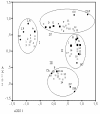Ethnobotanical knowledge in rural communities of Cordoba (Argentina): the importance of cultural and biogeographical factors
- PMID: 20003502
- PMCID: PMC2804588
- DOI: 10.1186/1746-4269-5-40
Ethnobotanical knowledge in rural communities of Cordoba (Argentina): the importance of cultural and biogeographical factors
Abstract
Background: The possibility to better understand the relationships within the men, the nature and their culture has extreme importance because allows the characterisation of social systems through their particular environmental perception, and provides useful tools for the development of conservation policies.
Methods: The present study was planned to disentangle environmental and cultural factors that are influencing the perception, knowledge and uses of edible and medicinal plants in rural communities of Cordoba (Argentina). Interviews an participant observation were conducted in nine rural communities located in three different biogeographical areas. Data about knowledge of medicinal and edible plants and sociocultural variables were obtained. Data were analysed by Principal Components Analysis (PCA).
Results: The analysis of data confirmed that medicinal species are widely used whereas the knowledge on edible plants is eroding. The PCA showed four groups of communities, defined by several particular combinations of sociocultural and/or natural variables.
Conclusion: This comprehensive approach suggests that in general terms the cultural environment has a stronger influence than the natural environment on the use of medicinal and edible plants in rural communities of Cordoba (Argentina).
Figures


Similar articles
-
Cultural, economic, and ecological factors influencing management of wild plants and mushrooms interchanged in Purépecha markets of Mexico.J Ethnobiol Ethnomed. 2018 Nov 20;14(1):68. doi: 10.1186/s13002-018-0269-9. J Ethnobiol Ethnomed. 2018. PMID: 30454000 Free PMC article.
-
To what extent are medicinal plants shared between country home gardens and urban ones? A case study from Misiones, Argentina.Pharm Biol. 2016 Sep;54(9):1628-40. doi: 10.3109/13880209.2015.1110600. Epub 2016 Feb 9. Pharm Biol. 2016. PMID: 26857000
-
Medicines in the forest: Ethnobotany of wild medicinal plants in the pharmacopeia of the Wichí people of Salta province (Argentina).J Ethnopharmacol. 2019 Mar 1;231:525-544. doi: 10.1016/j.jep.2018.10.026. Epub 2018 Nov 7. J Ethnopharmacol. 2019. PMID: 30414441
-
Native and exotic plants with edible fleshy fruits utilized in Patagonia and their role as sources of local functional foods.BMC Complement Med Ther. 2020 May 24;20(1):155. doi: 10.1186/s12906-020-02952-1. BMC Complement Med Ther. 2020. PMID: 32448223 Free PMC article. Review.
-
Ethnobotanical review of the Mapuche medicinal flora: use patterns on a regional scale.J Ethnopharmacol. 2009 Mar 18;122(2):251-60. doi: 10.1016/j.jep.2009.01.003. Epub 2009 Jan 8. J Ethnopharmacol. 2009. PMID: 19168122 Review.
Cited by
-
Food flora in 17th century Northeast region of Brazil in Historia Naturalis Brasiliae.J Ethnobiol Ethnomed. 2014 Jun 25;10:50. doi: 10.1186/1746-4269-10-50. J Ethnobiol Ethnomed. 2014. PMID: 24965737 Free PMC article.
-
Rizoma: a new comprehensive database on traditional uses of Chilean native plants.Biodivers Data J. 2022 Mar 4;10:e80002. doi: 10.3897/BDJ.10.e80002. eCollection 2022. Biodivers Data J. 2022. PMID: 35437394 Free PMC article.
-
Knowledge and use of wild edible plants in rural communities along Paraguay River, Pantanal, Brazil.J Ethnobiol Ethnomed. 2015 May 30;11:46. doi: 10.1186/s13002-015-0026-2. J Ethnobiol Ethnomed. 2015. PMID: 26025294 Free PMC article.
-
The effect of management systems and ecosystem types on bark regeneration in Himatanthus drasticus (Apocynaceae): recommendations for sustainable harvesting.Environ Monit Assess. 2014 Jan;186(1):349-59. doi: 10.1007/s10661-013-3378-x. Environ Monit Assess. 2014. PMID: 23959345
-
Cross-cultural comparison of plant use knowledge in Baitadi and Darchula districts, Nepal Himalaya.J Ethnobiol Ethnomed. 2018 Jun 11;14(1):40. doi: 10.1186/s13002-018-0242-7. J Ethnobiol Ethnomed. 2018. PMID: 29890995 Free PMC article.
References
-
- Maranta A. Los recursos vegetales alimenticios de la etnia Mataco del Chaco Centro Occidental. Parodiana. 1987;5:161–237.
-
- Plotkin M. Aprendiz de Chamán. Ed Emecé. Buenos Aires, Argentina. 1996.
-
- Pemberton R, Lee N. Wild food plants in South Korea: Market presence, new crops, and exports to the United Stateds. Economic Botany. 1996;50:57–70.
-
- Campbell B. The use of wild fruits in Zimbabwe. Economic Botany. 1987;41:375–385.
-
- Datta S, Banerjee A. Useful weeds of west Bengal rice fields. Economic Botany. 1978;32:297–310.
Publication types
MeSH terms
LinkOut - more resources
Full Text Sources
Medical

